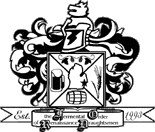
|

|

|

|

|

|
| May 2000 | Fermental Order of Renaissance Draughtsmen | Vol. 8 No. 5 |
The next meeting will be Wednesday, May 24 at Sisko's in Taylor. Sisko's is located on Monroe (between Telegraph and Southfield), just south of Vanborn. Their address is 5855 Monroe and their phone number is 313-278-5340. Sisko's also has a website at http://www.siskos.com/. May's Competition is German Lager that includes BJCP categories 2, 13 and 14. The BJCP miniguidelines follow the results of last month's competitions.
Last month's competition was "Weiss is Nice". The results are shown in the table below.
| Place | Brewer | Style | Points |
| 1st | Don Parisot | Weizenbock | 40 |
| 2nd | Craig Rinkel | Dunkelweizen | 35 |
| 3rd | Jim Racine | Bavarian Weizen | 33 |
May's competition is German lager the BJCP mini-guidelines are shown below.
2. EUROPEAN PALE LAGER
2A. Bohemian Pilsner [Editor's Note -- Yes, I know that Bohemia is in the Czech Republic, but we are not going to turn away any
for judging !]
Aroma: Rich with a complex malt and a spicy, floral, Saaz hop bouquet. Moderate diacetyl acceptable.
Appearance: Light gold to deep copper-gold, clear, with a dense, creamy white head.
Flavor: Rich, complex maltiness combined with pronounced soft, rounded bitterness and flavor from Saaz hops. Moderate diacetyl acceptable. Bitterness is prominent but never harsh, and does not linger: The aftertaste is balanced between malt and hops. Clean, no fruitiness or esters.
Mouthfeel: Medium-bodied, medium carbonation.
Comments: Saaz hops and low sulfate, low carbonate water provide a distinctively soft, rounded hop profile.
Overall Impression: Crisp, complex and well-rounded yet refreshing.
2B. Northern German Pilsner
Aroma: May feature grain and distinctive, flowery, noble hops. Clean, no fruitiness or esters.
Appearance: Straw to medium gold, clear, with a creamy white head.
Flavor: Crisp, dry and bitter. Maltiness is low, although some grainy flavors and slight sweetness are acceptable. Hop bitterness dominates taste and continues through the finish and lingers into the aftertaste. Hop flavor can range from low to high but should only be derived from German noble hops. Clean, no fruitiness or esters.
Mouthfeel: Light to medium body, medium to high carbonation.
Overall Impression: Crisp, clean, refreshing beer that prominently features noble German hop bitterness accentuated by sulfates in the water.
Comments: Drier than Bohemian Pilsner with a bitterness that tends to linger more in the aftertaste due to higher attenuation and higher sulfate water.
2C. Dortmunder Export
Aroma: Low to medium German or Czech hop aroma. Malt aroma is moderate.
Appearance: Light gold to medium gold, clear with a noticeable white head.
Flavor: Neither malt nor hops are distinctive, but both are in good balance with a touch of sweetness, providing a smooth yet crisply refreshing beer. Balance continues through the finish and the hop bitterness lingers in aftertaste. Clean, no fruitiness or esters.
Mouthfeel: Medium body, medium carbonation.
Overall Impression: Balance is the hallmark of this style.
Comments: Brewed to a slightly higher starting gravity than other light lagers, providing a firm, malty body and underlying maltiness to complement the sulfate-accentuated hop bitterness.
2D. Münchner Helles
Aroma: Grain and malt aromas predominate. May also have a very light hop aroma.
Appearance: Medium to deep gold, clear, with a creamy white head.
Flavor: Slightly sweet, malty profile. Grain and malt flavors predominate, with just enough hop bitterness to balance. Very slight hop flavor acceptable. Finish and aftertaste remain malty. Clean, no fruitiness or esters.
Mouthfeel: Medium body, medium carbonation, smooth maltiness with no trace of astringency.
Overall Impression: Characterized by rounded maltiness without heaviness.
Comments: Unlike Pilsner but like its cousin, Münchner Dunkel, Helles is a malt-accentuated beer that is not overly sweet, but rather focuses on malt flavor with underlying hop bitterness in a supporting role.
13. EUROPEAN DARK LAGER
13A. Munich Dunkel
Aroma: Munich malt aroma, with sweetish notes or hints of chocolate and toffee also acceptable. No fruity esters or diacetyl should be detected, but slight hop aroma is acceptable.
Appearance: Medium amber to dark brown, often with a red or garnet tint. Creamy light tan head, clear.
Flavor: Dominated by the rich and complex flavor of Munich malt. May be slightly sweet from residual extract, but should not have a pronounced crystal or caramel malt flavor. Burnt or bitter flavors from roasted malts should not be perceived. Hop bitterness is low but perceptible, with the balance tipped firmly towards maltiness. Hop flavor should be at the very edge of perception if perceived at all. Aftertaste remains malty, although the hop bitterness may become more apparent in this last phase of flavor perception.
Mouthfeel: Medium to medium-full mouthfeel, providing a firm body without being heavy.
Overall Impression: Characterized by depth and complexity of Munich malt and the accompanying melanoidins.
13B. Schwarzbier (Black Beer)
Aroma: Primarily malty, with low aromatic sweetness and/or hints of roast malt often apparent. Low hop aroma may be perceived. No fruity esters or diacetyl.
Flavor: Rich, full malt flavor balanced by moderate bitterness from both hops and roasted malt, providing a bitter-chocolate palate without being particularly dry. Low hop flavor and some residual sweetness are acceptable. Aftertaste tends to dry out slowly and linger, featuring hop bitterness with a complementary subtle roastiness in the background. No fruity esters or diacetyl.
Mouthfeel: Low to medium body.
Overall Impression: A beer that balances rich dark malt flavors with a perceptible bitterness from hops and roasted malts.
14. BOCK
14A. Traditional Bock
Aroma: Strong aroma of malt. Virtually no hop aroma. Some alcohol may be noticeable. Diacetyl or esters should be low to none.
Appearance: Deep amber to dark brown color. Lagering should provide good clarity despite the dark color. Head retention may be impaired by higher-than-average alcohol content.
Flavor: Rich and complex maltiness is dominated by the grain and caramel flavors of Munich and Vienna malts. A touch of roasty character may be present but is rare. No hop flavor. Hop bitterness is generally only high enough to balance the malt flavors to allow moderate sweetness in the finish.
Mouthfeel: Medium to full bodied. Low to moderate carbonation.
Overall Impression: A dark, strong, malty lager beer.
14B. Helles Bock/Maibock
Aroma: Moderate to strong malt aroma. Hop aroma should be low to none. Aromas such as diacetyl or fruity esters should be low to none. Some alcohol may be noticeable.
Appearance: Golden to amber in color. Lagering should provide good clarity. Head retention may be impaired by higher-than-average alcohol content.
Flavor: The rich flavor of continental European pale malts dominates. Little or no hop flavor. Hop bitterness is generally only high enough to balance the malt flavors to allow moderate sweetness in the finish. Perception of hops may be more apparent than in darker Bocks.
Mouthfeel: Medium-bodied. Moderate carbonation.
Overall Impression: A relatively pale, strong, malty lager beer.
14C. Doppelbock
Aroma: Intense maltiness. Virtually no hop aroma. While diacetyl or esters should be low to none, a fruity aspect to the aroma often described as prune, plum or grape may be present due to reactions between malt, the boil, and aging. A very slight roasty aroma may be present in darker versions.
Appearance: Gold to dark brown in color. Lagering should provide good clarity. Head retention may be impaired by higher-than-average alcohol content.
Flavor: Very rich and malty, infrequently a touch of roastiness. Invariably there will be an impression of alcoholic strength, but this should be smooth and warming rather than harsh or burning. Presence of higher alcohols (fusel oils) should be very low to none. Little to no hop flavor. Hop bitterness varies from moderate to low but always allows malt to dominate the flavor.
Mouthfeel: Full-bodied. Low carbonation.
Overall Impression: A very strong, rich, lager beer.
14D. Eisbock
Aroma: Dominated by malt. Definite alcohol presence. No hop aroma. No diacetyl or esters.
Appearance: Deep gold to dark brown in color. Lagering should provide good clarity. Head retention may be impaired by higher-than-average alcohol content.
Flavor: Rich malt and concentrated alcohol. No hop flavor. Hop bitterness just balances the malt sweetness to avoid a cloying character. No diacetyl or esters.
Mouthfeel: Full-bodied. Carbonation low.
Overall Impression: An extremely strong lager beer.
For the last three years the first Saturday of May has been designated National Homebrew Day (NHD) by the American Homebrewers Association. Homebrewers from around the U.S. and other countries brew in hundreds of locations and many chose to brew a highlighted recipe. This year s featured recipe, an American Pale Ale style, was a Sierra Nevada Pale Ale clone recipe, known as Nearly Nirvana Pale Ale . It was developed by local homebrewer, Chris P. Frey (Crispy) of Saline, Mi., after 18 attempts at first replicating and them modifying his favorite fermentable.
Each year Crispy has held a homebrew demonstration/picnic/get-together at his home. Crispy began
brewing when he moved to Michigan five years ago and has been passionate about the hobby ever
since. Soon after he joined the F.O.R.D. homebrew club in 1995, he learned that his great-grandfather
and great grand-uncle had moved from the Black Forest area in Germany to Grand Rapids, Mi., where
they opened up C. Frey & Brothers Brewery in 1863. They survived the onslaught of modern
distribution master Anhuser-Busch, only to succumb to prohibition. Today, Crispy is the treasurer of the
F.O.R.D. club and the equipment manager for the AABG. For more information on homebrewing clubs
and activities in SE Michigan, you can e-mail him at crispy275@aol.com.
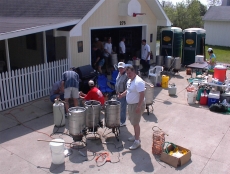
This year twenty-seven members of the Fermental Order of Renaissance Draughtsmen (F.O.R.D.) and the Ann Arbor Brewers Guild (AABG) showed up at his home this past May 6th to celebrate NHD andto brew some serious beers. As an added incentive, the National American Homebrewers Conference is to be held this upcoming June 22nd 24th at the Holiday Inn. This gave many celebrants the opportunityto brew up a batch for the conference.
By 9:00 am the air was filled with malty aromas as everyone began doughing in their grains into their
specific systems mash tun (a container where brewers combine water heated to specific temperatures
with a variety of crushed grains to convert the starches present into sugars). 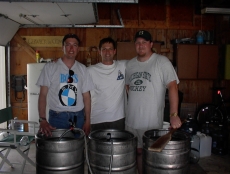 Systems ran from simple
extract kettles (utilizing pre-converted concentrated barley extract), to more technical Gott coolers, to
miniature 15-gallon microbreweries, or PicoŽ Systems that allow homebrewers the same controls and
variables as the big boys.
Systems ran from simple
extract kettles (utilizing pre-converted concentrated barley extract), to more technical Gott coolers, to
miniature 15-gallon microbreweries, or PicoŽ Systems that allow homebrewers the same controls and
variables as the big boys.
By noon the temperature had climbed to an uncharacteristic early May 90o and brewers began adding
their hops for bitterness, flavor and aroma. Later in the afternoon, after most brewers had cleaned up,
more of Crispy s friends from his motorcycle club, work, neighbors and family descended upon his
humble abode with side dishes and appetizers to feast on the 225 lb. pig that Mike O Brien had cooked
all day. After dinner and dessert some 100 people enjoyed the live tunes of the Electric Sunhouse Band.
Ten kegs of homebrew, along with one commercial keg of Greektown Lager (gratefully supplied by
local distributor Jim Racine) were enjoyed as well.
Ingredients for the Big Brew were donated or discounted by local merchants. John at Motor City Brewing Company donated the yeast and Scott Day, proprietor of a local homebrew shop; Brew & Grow in Livonia donated the hops. Scott also sold the grains at cost when a last minute sponsor was unable to fulfill their commitment.
This year, over 1600 participants brewed 3700 gallons of homebrew across the country at nearly 300
sites. Over 2,500 gallons of Nearly Nirvana Pale Ale were brewed along with over 1,000 gallons of
other styles of homebrew. Over 300 gallons were brewed right here in Michigan, with 165 gallons
brewed at Big Brew Site 52 The Barr House Brewery, second only to the 176 gallons brewed by the
Anchorage Brewery site in Alaska. Nice lagering seasons dudes!
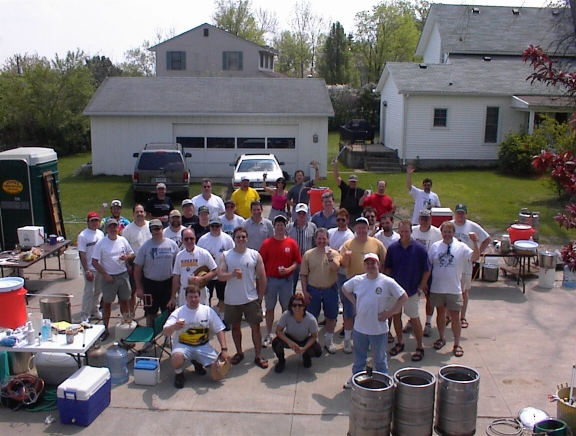
OK, boys and girls. The National Homebrewers Convention at the Holiday Inn, Livonia is just around the corner. If you are undecided about attending all or part of this event, take a peak at www.beertown.org and see the impressive line-up of talent that will be speaking! As I mentioned before, many are locally grown, Michigan natives who some of us have had the good fortune to meet and several have spoken at our club meetings.
The conference will unofficially begin Wednesday night as people come from around the world to go on a Michigan Pub Crawl. What a grand idea!
Thursday, June 22nd is the offical start of the event, with the final judging for the National Homebrew Competition going on all day. Winners earn pride, recognition and just ask Tyler Barber about the awesome trophy ;-)
During the competition, several speakers will present. Alex Kennedy will cover "How I learned to stop Worrying and Love the Beer", Dan McConnell will talk on Mead Judging and Ray Daniels (author of my favorite beer resource: Designing Great Beers) will speak on "IPA's Past, Present and Future".
Thursday night will bring one of the highlighted events, "Beers Without Borders". This is where the various homebrew clubs try to outdo each other with awesome eats, great homebrews and presentations! I will be borrowing a few beer cookbooks from Rich Byrnes and I promise a delightful repast. I am seeking both brewers and cooks to help us make the F.O.R.D. groaning board one to remember!
Friday brings more judging and our own David Cords, Scott Day and Mike O'Brien providing a Brewing Demo. Dan Fagan will discuss Cider, Jim Liddil "Recent Advances in Cleaning and Sanitation", and then Charlie P. will provide the Keynote address. This will be followed by Larry Bell speaking on the Pride and Passion of Brewing, Fred Eckhardt speaking on a Prohibition related theme and Peter Blum talking on the History of Brewing in Detroit, followed with a book signing.
Friday night brings Mike O'Brien providing the grub for the Blind Pig Roast. He used my picnic as a warmup for this event!
Saturdays speakers include Jeff Renner and Tom Plunkard on Pre-Prohibition Pils, Al Korzonas on "Small Changes, Big Improvements for 2000", Fred Scheer on Malting & Mashing, and Morton Meilgaard on Flavors. This will be followed with a members meeting/forum and then the Banquet and Awards dinner. Sunday will be a massive hangover, followed by Advils, water and then a bit of the hair of the dog!
Hospitality Suite:
The hospitality suite will feature our own 12-tap draft system and brews from a variety of local clubs (ever try to check a full corny as you board a plane?). The schedule looks like this:
Thursday, June 22nd
12 - 2 Capital City Brew Crew
2 - 4 Kansas City Bier Miesters
4 - 6 Firkin Homerackers
Friday, June 23rd
10 -12 Ann Arbor Brewers Guild
12 - 2 Prison City Brewers
2 - 4 Pontiac Brew Tribe
4 - 6 Chicago Beer Society
Immediately following Pig Roast - North State Brewers Coop
Saturday, June 24th
10 -12 F.O.R.D.
12 - 2 C.R.A.F.T.
2 - 4 Downriver Brewers Guild
4 - 6 Urban Knaves of Grain
The hospitality suite will be open as needed beyond these hours, and yours truely will have the key ;-)
Yes, you read that right, we have the Saturday morning slot! And you can blame me. I figured that some of you might want to participate but could not take the time off, so that was the only Saturday slot open. As if you couldn't guess, my room will be PARTY CENTRAL, so if you want to stop by and visit late into the night, just look for the open door and the people present. Let me know if you are interested in providing keggage for the Saturday slot!



This month's pictures include two future homebrewers Lindsay Hampo born on March 16, 2000 and Paige Barber born on April 19, 2000
Howard Klix Jr. and Marla Duffield were married on April 29, 2000 at the Henry Ford Estate in Dearborn. In addition to the usual refreshments, three homebrews, a nut brown ale (brewed by the bride and groom), a Sierra Nevada clone, and a raspberry wheat ale were served. Congratulations and best wishes to Howard and Marla!
The following series of questions and answers was posted the HBD starting with HBD number 3308 by Rob Moline, and is reprinted with permission of Rob. Dr. Cone worked (works?) at Lallemand, the yeast company which is famous for making the "Nottingham" strain of ale yeast. I have formatted the questions and answers for readability, but have not edited or abridged them in any manner.
In virtually every brewing text I have ever read, there are warnings against reusing dry yeast. The rationale for this is perhaps best summed up by Dave Miller: "Do not repitch slurries from dry yeast. Because all dry yeasts contain some degree of contamination, and because the contaminating organisms will grow from one pitching to the next, the only safe course is to use dry yeast on a one-shot basis." However, since I have begun maintaining a yeast ranch for members of the on-line brewing fraternity, the Brew-Rats, I have noticed that dry yeasts I have examined under the microscope have been at least as "clean" as yeast cultures derived from liquid yeasts. In any event, wouldn't it be possible to eliminate the entire question by use of the single-cell origin colony harvesting method? "Find a single colony on the original ager plate that is physically isolated from all the other colonies on the same plate. This colony is homogeneous in the sense that all the cells degenerate from the same parent. Thus this can be considered as a pure culture" (Nam Sung Wang Dept. of Chemical Engineering University of Maryland) The same instructions are given in the Advanced Yeast Culturing for Homebrewers: "Using a plate you can also "cone" your yeast stocks so that they originate from a single colony of yeast. This is a sure way of getting rid of potential bacterial contaminants..." The question is this; has this caution, as outlined by Miller, been overblown, at least using the procedures outlined by Wang and in the Advanced Yeast Culturing for Homebrewers document? I haven't been able to note any contamination of yeast cultures derived from dried materials. Is it possible that technical production improvements have made this advice obsolete, at least for those of us who "yeast ranch" rather than merely wash yeast for short-term storage? Your comments on this subject will be most welcomed. Rick Olivo
Rick, Until a few years ago the quality of the Active Dry Yeast for beer making was not up to the rigid standards required by the brewing industry. The beer yeast was marginally satisfactory for a one time use but not advisable for repeated pitching as Miller noted. That was satisfactory for many home beer makers because there was no interest in repitching. In recent years, companies like Lallemand's Dan Star, have made dramatic improvements in the quality of their beer strains. The wild yeast and bacteria levels now meet the rigid standards of such well know brewing institutes as Weihenstephan, Siebel, Herriot Watt and others. You should feel very confident in being able to repitch the Dan Star beer yeast as often as you repitch your liquid yeast. However, we feel that it is prudent practice to limit the repitching to two or three times at most. Even the big breweries, with all of their sanitary savvy, limit their repitching to less than 6 times The cost of dry beer yeast is such that it is economical to maintain minimum repitching practice. Many brew pubs do not attempt to recover yeast for repitching, they just rehydrate and pitch fresh each time.
I am pleased that you have noted the marked improvement under the microscope.
I have never been an advocate of single cell cultures. I have always isolated several (15 - 20) colonies and studied each separately in test tube and under the microscope. When I was satisfied that all were OK, I would then blend into one culture. This would prevent the isolation of a single strain that would be mutated or might have a weak gene.
Fermenting from a packet of ADY Beer Yeast is very simple. Fermenting from a single cell is rather involved. I realize that many of you like the challenge of preparing isolates and liquid cultures. Go to it. When the excitement and joy wears off, remember; there is ADY beer yeast.
I hope that Dr. Nam Sung Wang did not really mean that "all cells degenerate from the same parent." Also, I believe that "Using a plate you would also "clone" not "cone" your yeast stock- - - - - - .
Originating from a single pure colony of yeast is the first step in getting rid of potential bacterial contamination. Good laboratory and sanitary practices are equally important. You would be surprised how many single yeast colonies contain bacteria when you streak from an infected wort.
Miller's caution was well taken several years ago but is not as apropos for all suppliers of ADY beer yeast today.
Clayton Cone
Just for the record: In yesterday's HBD, Dr. Cone made this observation:
I hope that Dr. Nam Sung Wang did not really mean that "all cells degenerate from the same parent." Also, I believe that "Using a plate you would also "clone" not "cone" your yeast stock- - - - - - .
I was rather confused by these two word usages myself. I took "degenerate" to mean "originate" as "degenerate" has several rather ominous connotations that I feel fairly certain Dr. Nam Sung Wang did not mean to imply. I rather thought "cone" meant "clone" but again, I was not willing to put words in the good Doctor's mouth. I got a (charitable) C in my college "Bio for Dummies 101" class so I wasn't sure if these were specialized terms not known to dolts like me. It is heartening to know that others are "search and destroy" keyboarders too. At any rate, Many thanks to Dr. Cone (Spelling IS correct!) for his kind confirmation of my own experience.
My question is concerning the proper amount of dry yeast to pitch to a 5 gallon batch. Years ago it was always 1 (5 gram packet) to 5 gallons. A couple years ago it was two 5 gram packets. At present it has been recommended to pitch 15 or 20 grams of dry yeast. I believe its time to issue good firm advice on the real amount of dry yeast to pitch. (Ale & Lager).. Thanks for sharing your knowledge.. ernie baker
Ernie, I am glad that you brought this to my attention. It would be neat if there could be a label with a single inoculating rate that would satisfy all beer makers and all worts. The initial instructions for inoculation rates came from the Beer Kit makers 10 - 20+ years ago. They were well aware of the sensitivity of the home beer maker to cost, so they offered the minimum amount of yeast possible to do the job. A few pennies more to cover the cost of adding more yeast would lose them many customers. Today the kit makers and the beer yeast producers are aware that the home beer maker is willing to pay for quality and increased amount of yeast for pitching if it is needed to give improved control over the fermentation. Both are beginning to respond. Some label changes have already been made in response to the trend to increase the inoculating rates. Others will be made in the near future.
Built into the ADY Beer Yeast is a large trehalose reserve that gets the freshly rehydrated yeast off to a good start. It does not require as high a cell population for pitching as it does for the repitching.
For a 10 Plato wort, I would be comfortable with two packets / 5 gallons wort. If you are satisfied with the fermentation rate and the taste of the finished product you should stick with the 2 packets / 5 gallons. This will give you about eight million yeast cells per ml. of wort. If you are not happy with the fermentation rate and the attenuation of your particular wort then you should experiment with 3 or more packets.
If you go to a higher gravity wort and or dark wort you will need to experiment with higher pitching rates.
Clayton Cone
A few yeast questions that resulted from some competition comments:
Thanks for the help. Its about time to be brewing again. Pete Czerpak
Pete , I have no experience with Wyeast Fuller Strain 1968 so I cannot comment on it. I will make the comment that Wyeast, White Labs and G.W.Kent Inc are excellent sources of liquid yeast.
It is not uncommon for yeast to produce diacetyl. Studies have shown that there is a doubling of Diacetyl production with the increase of cereal adjuncts in the wort from 20 % to 40% and another doubling when the adjunct is increased to 50%. So it is possible that a 10% addition of flaked maize would result in a slight increase in diacetyl. It is interesting to note that yeast produce diacetyl during the early part of the fermentation and can in turn consume the diacetyl at the end of the fermentation if the yeast are alive and healthy.
Because diacetyl is so commonly produced, at some level, during the brewing fermentation, most brewmasters are prepared for it. They include a "diacetyl reduction stage" a secondary fermentation at the end of the fermentation for every batch either in the same fermenter or in a separate tank. The more active the yeast, the higher the cell count, the warmer the temperature, the faster will be the diacetyl reduction. Usually 1 - 3 days is scheduled to reduce the diacetyl and other procusors to a level below 0.1ppm.
If you detect diacetyl at the end of fermentation, you should allow the yeast a day or two to remove it before filtering. If you note the diacetyl after filtering you should add fresh yeast to the beer and allow a few days for the yeast to reduce it. A trace amount of fresh wort would assist the new yeast to do the job.
2. I have no experience with the Wyeast Weihenstephen strain so I cannot comment on what it can do. I am assuming that you are asking about cold conditioning of the yeast at the end of the fermentation. I can say that the phenols come from the mashing and will probably not be effected by cold conditioning. Cold temperature conditioning should have little effect on the 'clove' or 'banana' character of the beer.
Clayton Cone
Dr. Cone: While you were at MCAB I last year, in a conversation with Houston meadmaker Leroy Gibbons you detailed a pitching / rousing / feeding program for mead that was radically different from what most of us had seen. As I recall, it involved adding small amounts of nutrient at various times after the initial pitch, and then shaking / stirring the mead to rouse the yeast and eliminate dissolved CO2. I know that Leroy has had *very* good results with this program, and now raves about it. (His meads that were produced using it have also won many awards.) Would you be so kind as to detail this routine for the HBD collective? Thanks again for your great participation in the HBD! All the best -- Louis K. Bonham
Louis, Thanks for asking about Mead production. Your outline covers the essence of the subject very well. I will briefly elaborate on the on the subject.
Several years ago, I visited about 50 Meadaries in several countries. It was not uncommon to find fermentations that had not completed after 3, 6 and even 9 months. It was accepted that this was normal. Perhaps the bees had put preservatives in the honey to protect it from spoilage and this was what made the fermentations so sluggish. Slow fermentations were accepted as part of mead making; it might even be necessary, to produce the best mead.
At that time I began to do studies on 'difficult' fermentations: honey, corn syrup, rice syrup, cane sugar, highly polished juice from concentrates and ultra filtered single strength juice. It quickly became apparent that they had all or part of the following problems in common (honey, corn syrup, rice syrup and cane sugar has all of the problems, concentrates and ultra filtered juice have part of the problem):
Adhere to good sanitary practices.
Follow the Yeast rehydration instructions.
Use temperature to control fermentation rates and kind of ester profile: 85 - 90 F should take less than 1, 60F should take about 2 - 3 weeks.
When you have completed the fermentation you can then decide how long you want the mead or wine to remain on the yeast. If you want it to be light, fresh and fruity, you can remove the yeast and filter immediately. If you desire some yeasty tones and perhaps a little oak you can leave it on the yeast and or in the barrel as long as you desire.
With a reasonably rapid fermentation, you can decide on how long you want leave the fermented material on the yeast and age it. With a sluggish fermentation, the yeast is in command and decides how long.
With a health, vigorous fermentation you will get the very best flavor and aroma profile out of your chosen yeast.
Clayton Cone
I understand that in aerobic yeast propagation the goal is to provide a continuous supply of oxygen and glucose to an actively growing, non-fermenting culture in order to maximize biomass and minimize (eliminate) ethanol production. To do so one must provide glucose so that the concentration of glucose in the culture never exceeds about 0.4% (w/v). Otherwise, the yeast will shift into fermenting the glucose. Thus, one must continuously infuse glucose at a rate that matches its utilization, which I assume increases exponentially as the biomass increases exponentially. (Please correct me if I am wrong on any of the above.)
The best means of controlling the glucose concentration in the medium would be to continuously monitor the glucose concentration in the culture and to adjust the glucose infusion rate accordingly. However, without a means of monitoring glucose concentrations, I would like to estimate the rate of glucose utilization of the culture from published literature values and infuse accordingly. Can you (or anyone else) provide me the approximate rate of glucose utilization for an aerobic, non-fermenting culture in the log phase of growth, assuming doubling times of 2 hours?
I assume the units would be something like moles glucose/min/g biomass or moles glucose/min/million cells. Fred L. Johnson
Fred Johnson, I do not have the exact data that you are looking for at my finger tips. I am heading for the airport in a few hours for a three week business trip to Germany, Austria, Hungary and Czech Rep. and do not have time to do your question justice. I will be back in touch with you when I return.
The sugar to biomass transfer is a simple calculation if you do not take into account efficiency, bubble size, O2 transfer at different times during the fermentation, temperature, Nitrogen and Phosphate and other nutrient additions, and osmotic pressure.
You might be interested in the fact that we do not monitor the sugar level in the fermentation at any one moment by sugar analyses. We monitor the O2/ CO2 ratio in the stack gas to determine the desired O2 / glucose balance. We increase or decrease both the air and sugar feed as desired to achieve optimum biomass/optimum cell composition and optimum yeast synchrony.
Tell me a little bit about your interest in this subject.
Clayton
Dr. Cone,Should I oxygenate/aerate my wine juice/must before pitching the dry Lalvin starter or any of the liquid yeasts?I use a stone and bottled oxygen for 1 minute on my beers. How long should I apply to wine?Thank you and enjoy your retirement. I hope all the beer and wine making friends you have made along the way keep you well supplied with quality beverages for the rest of your life.Cheers, Wendell Ose, Reston, Va
Windell, It is always wise to aerate the must. Usually the oxygen is wasted when you Oxygenate/aerate before the yeast have started to multiply. The dissolved oxygen is bound by must components and the SO2 before the yeast has a chance to pick it up. One - two minute of bottled oxygen at about the 14 th hour and about the 24th. hour should be enough or 30 minutes aeration with regular air through a stone at 14th and 24th hour should be adequate for a 5 gallon fermenter. Clayton
Dr. Cone wrote in response to a previous question, >The low levels of polysaccharides and manoproteins in wine can be detected >more readily because of the lighter structure of wine. Beer already has a >sizable amount of carbohydrates (extracts), however, who knows what >contributions these compounds can have on beer. >My company is in the process of building a factory to produce these >compounds for the wine industry, you can bet that we will now explore its >use in the brewing industry.
Thank you again for your help! michael rose
Clayton Cone
Announcing the E.T. Barnette Homebrew Competition!
This is an AHA sanctioned competition.
The grand prize for Best of Show is $500!!!
Five Classes will judged: Dark Ale, Light Ale, Dark Lager, Light Lager and Specialty/Mixed style.
Mead entries are welcome.
Entries will be accepted: July 6-12, 2000
Entry fees: Submit three 12-16 oz brown or green crown capped bottles and a check or money order for $5.00 in U.S. funds.
Judging: The first round of judging will take place on July 15th. The final, Best of Show round of judging will take place on July 19.
More information as well as Entry and Bottle ID forms may be found at the following URL: http://www.mosquitonet.com/~stihlerunits/ScottsDen/Beer/Events/Events.html
Note that a slightly different URL for this event has been posted on various websites; the original URL has been linked to the above website.
Should you have any questions about the competition or are interesting in judging contact Scott Stihler at (907) 474-2138 or stihlerunits@mosquitonet.com.
If you know of anybody that may be interested in entering this competition please forward this message to them.
A couple of short articles caught my attention. The first was from a Sigma Xi ( a national science society) mailing list. It gives a broken link to a London Sunday Times Article. I was able to find the article by going to the Sunday Times back issues URL and doing a search on Alan MacFarlane. It the May 10th issue. If you bring up the index to this issue you can also find the article.
A taste for beer surely has slain the ambitions of people through the ages. And taking tea is one of the more stereotypical rituals of the leisure class. But a Cambridge researcher is urging us not to sell the two beverages short; in fact, he posits that they have indirectly fueled modernity.
Like so many other historians, Alan MacFarlane, an anthropologist at King's College, Cambridge, has long obsessed over the enigma of the Industrial Revolution -- modernity's Big Bang. After looking at the revolution as a combination lock never to be opened without the requisite number and location of precise conditions, MacFarlane finds several contenders short on just a few of the factors. For instance, Holland had it all but coal, while China also had many factors.
In a documentary series on British television, MacFarlane asserts that the
antiseptic properties of Britain's favorite drinks, tea and beer, fueled the
revolution. The tannin in tea and the hops in beer, plus the fact that both
are made with boiled water, allowed urban communities to flourish at close
quarters without succumbing to waterborne diseases such as dysentary, says
MacFarlane.
The second item I spotted was on the "newscripts" page, page 104, of the May 8, 2000 Chemical & Engineering News. Karin M. Höld at the University of California, Berkeley and her colleagues have finally worked out the mechanism of neurotoxicity of alpha-thujone, the toxic agent in absinthe. The thujone comes from the wormwood oil used in making absinthe They published their findings in the Proceedings of the National Academy of Science USA, 97, 3826 (2000). By performing a search on absinthe in the abstract field on the Proceedings of the National Academy of Science's back issue search page, http://www.pnas.org/all.shtml, I was able to find the abstract and article.
For those of you looking forward to June's Competition, the style is porter, BJCP category 15. The descriptions from the BJCP miniguide follow.
15. PORTER 15A. Robust Porter 15B. Brown Porter Some recipe references from the web include Gambrinus' Mug Recipe Collection and the Cat's Meow3 at the http://brewery.org, one of my favorite homebrew web sites. The brown porter collection at Gambrinus's mug is at http://brewery.org/brewery/gambmug/toc/gm.1_6_1.toc.shtml with the corresponding robust porter entry at http://brewery.org/brewery/gambmug/toc/gm.1_6_2.toc.shtml. Cat's Meow group 5 at http://brewery.org/brewery/cm3/recs/05_toc.html includes recipes for stouts and porters.
June's Competition
Aroma: Roast malt or grain aroma, often coffee-like or chocolate-like, should be evident. Hop aroma moderate to low. Fruity esters, and diacetyl, are moderate to none.
Appearance: Dark brown to black color, may be garnet-like. Clarity may be difficult to discern in such a dark beer. Head retention should be moderate to good.
Flavor: Malt flavor usually features coffee-like or chocolate-like roasty dryness. Overall flavor may finish from medium sweet to dry, depending on grist composition, hop bittering level, and attenuation. May have a sharp character from dark roasted grains. Hop flavor varies widely. Diacetyl moderate to none.
Mouthfeel: Medium to medium-full bodied. Low to moderate carbonation.
Overall Impression: A substantial dark ale with complex roasty malt, hop and fermentation characteristics.
Aroma: Malt aroma with mild roastiness should be evident. Hop aroma may be moderate to low. Esters and diacetyl may be moderate to none.Appearance: Medium brown to dark brown in color. Clarity and head retention should be fair to good. Flavor: Malt flavor will include mild to moderate roastiness. Hop flavor low to none. Hop bittering will vary the balance from slightly malty to slightly bitter. Diacetyl, and sourness or sharpness from dark grains, should be low to none. Mouthfeel: Medium-light to medium bodied. Low to moderate carbonation. Overall Impression: A fairly substantial dark ale with some roasty characteristics. Comments: Softer flavors, lower gravities, and usually less alcohol than robust porter. More substance and roast than brown ale. Some versions are fermented with lager yeast.Balance tends toward malt more than hops.
![]()
Beer Events, Meetings & Competitions
Gabrielle Palmer
Al Czajkowski
"When I heated my home with oil, I used an average of
800 gallons a year. I have found that I can keep comfortably
warm for an entire winter with slightly over half that
quantity of beer."
--Dave Barry
...Saw this on the HBD site.
A bear walks into a bar in Billings, Montana and sits down. He bangs on the bar with his paw and demands a beer. The bartender approaches and says, "We don't serve beer to bears in bars in Billings."
The bear, becoming angry, demands again that he be served a beer. The bartender tells him again, more forcefully, "We don't serve beer to belligerent bears in bars in Billings."
The bear, very angry now, says, "If you don't serve me a beer, I'm going to eat that lady sitting at the
The bartender says, "Sorry, we don't serve beer to belligerent, bully bears in bars in Billings."
The bear goes to the end of the bar, and as promised, eats the woman. He comes back to his seat and again demands a beer. The bartender states, "Sorry, we don't serve beer to belligerent, bully bears in bars in Billings who are on drugs."
The bear says, "I'm not on drugs."
The bartender says, "You are now. That was a barbitchyouate."
Twas three months before Christmas and in the Northeast
the weather was cooling, heading towards the big freeze.
The tap was still dripping, but only a tad,
most brews from last season had already been had.
The shelves were near empty of brewing supplies,
last season's best grains were invaded by flies.
The bottles laid dusty in large open crates,
the carboys grew mold like the fur on great apes.
When one Sunday morning the brewster arose,
said, Today, I shall start as she sprang to her toes.
She dumped all the grains that were feeding the bugs,
and while tallying the rest gave plenty of shrugs.
The brew fridge sat empty of all her best brews,
but some leftover hops added positive news,
she continued to poke and whence almost she ceased
in the furthest back corner was a starter for yeast.
The top of the flask had an airlock in place
but the liquid inside smelled of rubber glue paste.
With the list in her hand of remaining supplies,
she sat down at the table and prepared to decide,
what ales should she brew that she'd liked in the past.
Should she venture to try a lager at last?
A holiday ale should be the first brew,
it would have several months for the spices to stew.
A brown ale would be next, then a porter would follow,
she would brew a light ale for the neighbors to swallow.
IPA, bitter and stout would all grace her pans,
but she needed a lager to pour black and tans.
She decided to try an oktoberfest first,
then maybe a helles would help quench her thirst.
Since pilsners were good in the hot summer heat,
she'd brew this beer last, so that it would keep.
The brews were decided, now came the best part.
Which recipes to use, from the past, or depart?
With her brew list before her she sat at the table
the list of ingredients read like rhymes of a fable.
At last she sat back for her list was complete,
but she laughed with amusement as she tallied the sheet:
sixty three pounds of grains, eight pounds of fresh hops
the owners would love her at local brew shops.
The long list included twelve cases of malt,
three amber, four light, five dark and some salt.
She purchased ten packs of the best liquid yeast,
plus some extra dry malt so the yeast could then feast.
With a trunkload of goods she pulled into her yard,
lugging boxes of malt was especially hard.
That night was the night she would start her first batch
first make up a starter, then rest she would catch.
The next day began the first brew of the year,
carting brew pots upstairs she began without fear.
The grains she would treat to a single step mash,
she'd then boil all malts `til one hour had past,
adding hops now and then, some to bitter, some for taste,
then she'd cool the wort down in the sink with all haste.
The fermenter sat waiting, sanitized, lid unhitched,
the temp was now right, the yeast could be pitched.
All snuggled in bed she dreamt of her brew,
but the sudden loud bang it made when it blew,
sent her down to the cellar as quick as can be
and what to her wondering eyes did she see?
The airlock she found was five feet from the brew,
the hop mess laid scattered like week old beef stew,
She stood there and watched kraeusen ooze from the top
then she realized the worst of it really had stopped.
With the carboy all clean and the airlock in place,
she returned to her dreams of the Great Home Brew Race.
(The crowd all held mugs, the racers were lean,
each riding the track on their homebrew machines.)
It was now Christmas Day and the family was near,
each person was anxious to try home brewed beer.
When the brewster emerged with the keg they all cheered,
Hoppy Christmas to all and a Malty New Year!
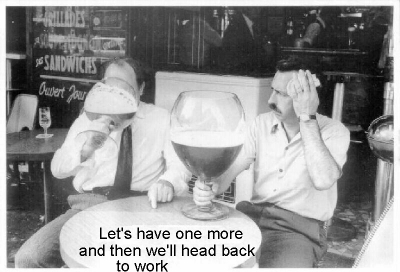
| Ye Olde Brew News
published by the F.O.R.D. Homebrew Club |
|
| Editor:
Tony Tantillo Contributors:
Club Officers:
|
F.O.R.D. is a private, non-profit organization of homebrewers. The main goal of this club is to
promote awareness and appreciation of the quality and variety of beer; to share information regarding technique, equipment and skill
required to brew quality homemade beer; and to encourage responsible use of beer as an alcohol-containing beverage.
Correspondence should be directed to:
Phone: 810-795-0512
Visit our website at: http://www.be.ford.com/brewers/
current circulation... 125 |